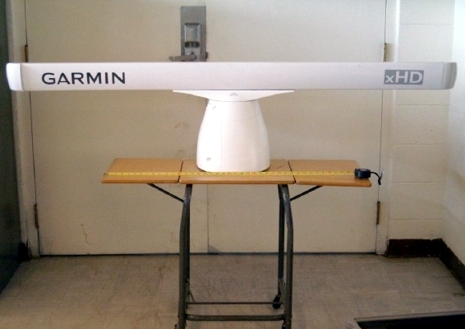Radar teases: Garmin goes big, Panbo gets wet

Thanks to Rich Owings, who runs the excellent GPSTracklog site, we now know that Garmin will soon introduce four new open array radars. The photo above comes from deep within the FCC equipment authorization database (sorry, linkage not possible), where anyone as patient as Rich might have discovered that four new Garmin radars were granted approval on Friday. The model designations are GMR 604, 606, 1204, and 1206 — which strongly suggest that they range from a 6 kW 4 foot array to a 12 kW 6 foot unit (hello, big yachts and sport fishermen) — and which will probably be sold in two parts like Garmin’s existing open arrays. But what the heck is “xHD”…?…
Well, frankly, I can only guess that “xHD” means Garmin thinks they’ve reached a performance level near Furuno’s “Ultra” and Raymarine’s “Super” in the valuable but vague world of High Def radar imaging. We’ll probably have to wait for the actual product introduction to know more, though perhaps some enterprising Panbot can glean further details from the testing files posted at the FCC. You go to “FCC ID Number Search” at the bottom of the general FCC search tools page, where a 2009 Date Range and “MDR Marine Radar” Equipment Type will get you both Garmin’s and Navico’s new radars. (Note that leading zeros are required in the date fields, because that’s how the FCC rolls 😉
Speaking of Navico, I was so keen to try the Broadband Radar test unit — and was so tired of the endless rain we’ve been having (not to mention the flakiness that’s haunted the Panbo server for days) — that I bolted the thing to Li’l Gizmo and headed to the lake. While you would normally back down alongside ramp and float, launching a boat yesterday was a freeform operation! But I wasn’t the only one determined to go boating regardless. I came across plenty of kayaks and outboards, and even water skiers, all of which showed up pretty impressively on Broadband. More soon.














More soon?… MORE SOON??? No Ben; Phlebotomists, Process servers and Criminal Trial Judges are not allowed to say that. You shouldn’t either. Just a simple teaser photo would suffice!
Ben- I checked on the FCC website and the radar is a standard Magnetron based Marine Radar with 6 and 12 Kw transmitters so your supposition is accurate.
Theoretical range resolution is 50ft out to 0.75 Nmi, 75ft to 1 nmi and 125ft to 2 Nmi and so on. There are a great number of pulse lengths associated with the radar. These are likely matched to distances so that the radar provides optimum resolution for each display and max sensitivity.
But if you go back to the Honeywell Pulse compression radar – the range resolution – providing 35ft resolution to 5 Nmi and 62 ft resolution to 10 Nmi is still unbeaten, except perhaps at very short ranges by the Navico Broadband Radar.
In looking at the magnetron pulse shapes, I found that the very shortest pulses are not exactly “square” and do not quite reach the full 100 nSec pulse length. They vary from as short as 40 nSec to 60 nSec and out to 90 nSec depending the model of the radar. On the one hand those shorter lengths would improve resolution but reduce sensitivity due to the lower radiated average power and the wider required receiver bandwidths. So the actual on the water demo should be interesting.
Building a marine radar with digital filters that can be altered to provide a “matched filter” response to every pulse length is the great achievement in this radar. That is all very high tech and will be a credit to the system performance – but it can be topped by solid state pulse compression radar systems. I suspect if the software was well done then the new Garmin radar will be a good competitor to existing Magnetron systems.